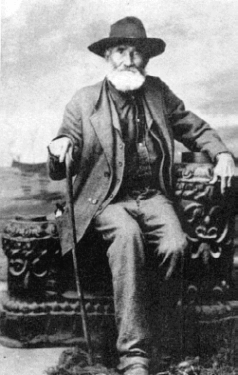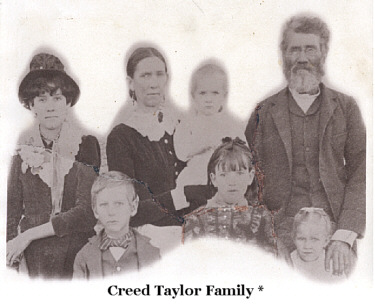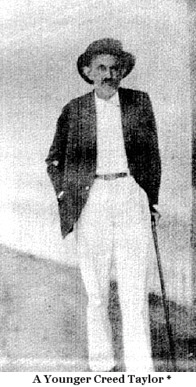In Search of Creed Taylor
By Charles M. Yates
![]()
There are many strange tales in Texas history and Texas historiography and, suprisingly, new ones keep coming to light. This is not so much a story of a man named Creed Taylor as it is a story of Texas history and how things aren't always what they seem to be on the surface. It's also a story about why we shouldn't automatically believe everything we read.
Creed Taylor was one of the few men of that rare breed who took part in a great many of the major events of nineteenth century Texas and survived to tell about them. During the Texas Revolution, Taylor participated in the Battle of Gonzales, the "Grass Fight", the Battle of Conception, the Storming of Béxar and the Battle of San Jacinto, but that was not the end of his fighting days. He took part in the Battle of Plum Creek, fighting against the Comanches in 1840 and fought the Indians in several other battles as a Texas Ranger under Captain Jack Hayes. When the Mexican Army invaded in 1842, Taylor fought them at the Battle of Salado Creek and was severely wounded. In 1846 he signed on with the United States forces under General Zachary Taylor (a distant relative) and fought in many of the major battles of the War with Mexico. Having survived over twenty years of almost constant fighting, Taylor then enlisted in the Confederate Army in 1864 and served with distinction in Colonel John Ford's command. In the latter part of the nineteenth century, he was one of the patriarchs of the Taylor faction of the notorious Sutton-Taylor Feud that plagued DeWitt County and the surrounding area. He died in Kimble County on December 26, 1906, at the ripe old age of 86 and is buried in the Noxville Cemetery just southeast of Junction, Texas.
During the Texas Revolution, Taylor participated in the Battle of Gonzales, the "Grass Fight", the Battle of Conception, the Storming of Béxar and the Battle of San Jacinto, but that was not the end of his fighting days. He took part in the Battle of Plum Creek, fighting against the Comanches in 1840 and fought the Indians in several other battles as a Texas Ranger under Captain Jack Hayes. When the Mexican Army invaded in 1842, Taylor fought them at the Battle of Salado Creek and was severely wounded. In 1846 he signed on with the United States forces under General Zachary Taylor (a distant relative) and fought in many of the major battles of the War with Mexico. Having survived over twenty years of almost constant fighting, Taylor then enlisted in the Confederate Army in 1864 and served with distinction in Colonel John Ford's command. In the latter part of the nineteenth century, he was one of the patriarchs of the Taylor faction of the notorious Sutton-Taylor Feud that plagued DeWitt County and the surrounding area. He died in Kimble County on December 26, 1906, at the ripe old age of 86 and is buried in the Noxville Cemetery just southeast of Junction, Texas.
These are all facts that can be substantiated from military records, letters and other official documents. There is also no doubt that Creed Taylor was a wealth of information concerning the volatile events of mid-nineteenth century Texas, but he left few, if any, written accounts of those years. He did, however, relate the details of his experiences to a gentleman named John Warren Hunter (1846-1915).
Hunter, who lived near Brady, Texas (some 50 miles north of Noxville), was an avid, amateur Texas Historian who published many articles and magazines on the subject. Hunter's research included interviewing the participants involved in the historical events and then massaging their recollections into something that would be more palatable to readers. For the time period and his level of training, Hunter seems to have been fairly competent at recording these stories and wrote some interesting articles from them, however, as is often the case with historians, he was never successful at making a great deal of money from his writings and his correspondence reveals that he was often in monetary straits.
Enter James T. DeShields (1861-1948). DeShields was another avid amateur historian from Farmersville, Texas (near Dallas), who collected manuscripts and articles on Texas history and wrote extensively on the subject1. One of his most often quoted books is Tall Men With Long Rifles which was subtitled "The glamorous story of the Texas revolution, as told by Captain Creed Taylor, who fought in the heroic struggle from Gonzales to San Jacinto." The book records the reminiscences of Creed Taylor as told to DeShields. The only problem with these reminiscences is that there is no evidence that DeShields ever talked to Taylor and there is ample circumstantial evidence that Taylor and DeShields never communicated or even met.
In a letter from Hunter to DeShields dated March 1, 19072 , Hunter introduced himself to DeShields and states that "From the Historical department of the San Antonio Express, I learn that you are gathering material for a Texas Frontier History and that you are in quest of data etc." He goes on to explain that "For nearly 50 years I have been a close and devoted student of our early Texas affairs-" He explains his research on Creed Taylor and how "I knew him well - intimately - and the story of his eventful life was given me from his own lips." Hunter goes on to tell DeShields that he completed Taylor's life story, entitled Eight Years on the Texas Frontier, or Life of Captain Creed Taylor, in manuscript form in 1893 and had attempted to have it published. For lack of money or stringent constraints by publishers, Hunter was unable to have the manuscript published. Then comes the pitch: "Being unable to have the work gotten out in book form I offer the MSS for sale at a price that will enable the purchaser to make a handsome profit." The letter continues with a prospectus of the book and its potential sales and descriptions of other projects Hunter is working on3.
The DeShields Papers are full of correspondence between Hunter and DeShields discussing a myriad of subjects, but on July 1st, 1907, Hunter signed a contract which states, in part, "I have this day sold transferred and delivered to the said J.T. DeShields a certain MSS. (unpublished) Life of Captain Creed Taylor - with all reminiscences biographical sketches notes etc - belonging thereto with this MSS - I hereby transfer all rights and titles as author, owner, publisher etc - of said life of Creed Taylor to James T. DeShields with privilege of using said MSS in any manner he may deem proper or [unintelligible] All copyright privileges are to be transferred to James T. DeShields."4

It is interesting to note that in the final published form, DeShields never mentions Hunter, his interviews with Creed Taylor or his manuscript. It is also interesting that in Hunter's original manuscript, DeShields marked through, by hand, all third person references and replaced them with first person references, so that a sentence that might have originally read "Creed Taylor fought in the Battle of San Jacinto" would read "I fought in the Battle of San Jacinto."5 This editorial license gives the reader the impression that Creed Taylor wrote the book or at least dictated the reminiscences to DeShields directly. Neither is the case.
This very confusing style of editing in itself, causes a great many problems for the researcher, however DeShields compounds the confusion by adding details to Taylor's story that were not included in the original manuscript. A good example of this is found in one portion of the final book. DeShields has Taylor recalling very detailed descriptions of the "Come and Take It" [Gonzales] flag and the Dawson [Dodson] flag and their origins, however in Hunter's original manuscript, no flags are mentioned at all. If the flag descriptions were not in Hunter's original manuscript and DeShields never communicated with Taylor, where did the descriptions come from?
The descriptions were inserted by DeShields. It was very common for writers of DeShields' era to borrow heavily from previous works without giving proper credit to the previous authors. The intent was to provide the reader with a better story, not a more accurate story. Many passages of Tall Men With Long Rifles resemble, in wording and spelling, works that were published prior to its compilation.
The only conclusion one can draw from this is that Hunter interviewed Creed Taylor and wrote Taylor's story so that readers of that age would enjoy it. To that end, embellishments were added to the original interview material to obtain a readable manuscript. DeShields then bought the manuscript and embellished it further adding still more information from previously published accounts and changing the narrative view of the story. In both instances the authors, for readability's sake, gave the impression that the words, embellishments and added information came directly from Creed Taylor. The vast majority did not.
Tall Men With Long Rifles is indeed a good read, but because it is an embellishment of an embellishment with additions, it cannot be seriously taken as a verbatim historical account of events as recounted by Creed Taylor. In point of fact, the only way we might have some semblance of an idea as to what information Taylor originally provided is to take Hunter's original manuscript and laboriously remove all information that Hunter may have obtained from other sources. The type of document deconstruction methodology needed would be similar to the type Biblical scholars have attempted to use on the four Christian gospels in an attempt to reconstruct an earlier work known as the "Q" document.
There's an old saying that "God makes history, but only historians can change it". From time to time we get the opportunity to correct our "changes". I think Creed Taylor deserves that courtesy and I think God would appreciate the honest effort.
On The Road Again

On June 11, 1999, Bob Burney, a long time friend of mine, and I went in search of Creed Taylor. We left Austin, with county map book in hand, about noon and pointed my little Toyota pickup west down US Highway 290. With good weather and good conversation, the miles slipped by. Through Johnson City and past Fredericksburg we traveled until we reached the small town of Harper. A little less than 5 miles past Harper we turned north on to FM 479 bound for the community of Noxville. This is where we encountered another anomaly concerning Creed Taylor.
Noxville is clearly marked on several of my maps. These maps, like Taylor's life history, all seem to come from one source and that source has the Noxville Community mislocated by almost six miles too far west. Not to worry. Bob and I had "been down this road before" and we know that where there is a will there is a way. The lone evidence on the highway of the existence of the community of Noxville is a sign that says "Noxville Cemetery" which points to a small dirt road to the right. To make a long story short, Bob and I covered most of southeastern Kimble County and got to meet and talk to some pretty interesting folks along the way. The general consensus was that the road to the cemetery was behind the Old Noxville Schoolhouse, which we had passed at least a half dozen times in our flailing around. Finally, we found the schoolhouse and the alleged road behind it. After covering a good twenty miles on dusty county roads, we found the turn to the "behind the schoolhouse" road about a half mile from were we turned off the main highway.
As we drove down this road, we noticed that the quality of the road deteriorated quite rapidly. So much so, that I was glad my truck had four wheeled drive. We eventually came to a ford on the Little Devils River and the conclusion that we were, once again, on the wrong track. There wasn't any room to turn around so we forded the creek and just after exiting the creek spotted a small yellow sign in the bowels of a cedar bush that said "Cemetery ->"!! Eureka!! A hundred yards further and around a corner and there it was.
A prettier sight would be hard to find and not just because we had been searching half the afternoon for it. The Noxville Cemetery is a sizeable cemetery for being out in the middle of nowhere and is absolutely beautiful. The grass had been mowed, the graves were all decorated or had flowers on them, the fence was in good repair and it was evident that the neighbors and relatives of the deceased take great care and pride in the place.
Creed Taylor's grave is about half way back from the entrance and a little to the left. The red tombstone is a relatively new one as compared to others in the cemetery dating from the same time of his death and the State of Texas has placed a pink granite marker at his feet. After paying our respects and taking some photographs, Bob and I toured the rest of the cemetery and then spent some time under a pavilion making notes and enjoying the surroundings. I'll say one thing for Mr. Taylor: he couldn't have picked a more beautiful spot in which to lay his weary bones.
After enjoying the afternoon in a beautiful part of the Texas Hill Country, we loaded up and headed into Junction for a vanilla milk shake at the Milky Way hamburger stand. Finding the Noxville Cemetery and Creed Taylor was the high point of the day, but that milk shake was a very close second!
Sic Semper Texanus,
Charlie Yates
1New Handbook of Texas, DeShields, James Thomas
2The date on the letter is actually March 1, 1906, however Hunter states in this letter "His [Taylor's] death occurred at his home in Kimble Co. on the 27th of last December" As all official records state that Taylor died in 1906, the letter must have been written in 1907 and Hunter simply misdated it. Hunter also places Taylor's death one day later, but this could be explained as the day he received the news. At any rate, it is far less important than the year.
3James T. DeShields Papers, DRT Library, San Antonio
4Ibid
5James W. Hunter Literary Effort, Texas State Archives
* Special Thanks to Bena Kirkscey for the these Taylor Family photographs.
TLA Homepage TLA Membership General Rules and Reg.s